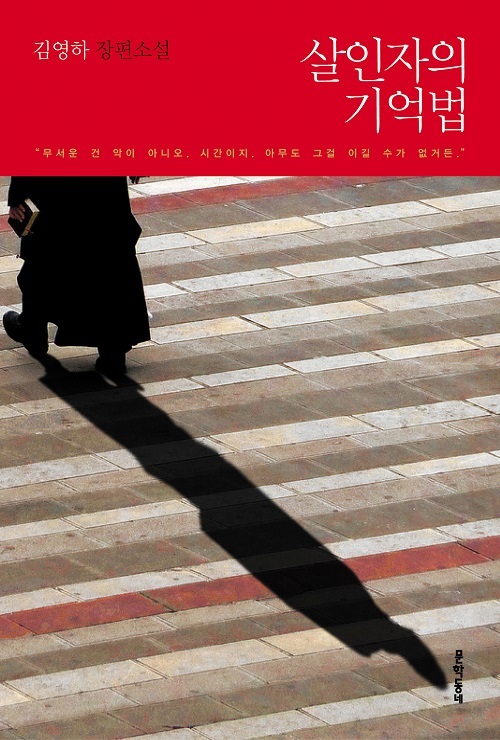Murder as poetry, metaphor
Kim Young-ha’s latest novel offers eerie glimpse into human memory
By Korea HeraldPublished : Aug. 1, 2013 - 20:12
Choreographer Hong Sung-yup’s recent piece “The Dog and the Shadow” was, in many ways, a dance about memories and how they shape us into who we are. Hong used feathers and tiny pieces of cotton and paper to symbolize one’s distant and fading memories ― light, insignificant, floating easily through the air.
Hong said he fears developing Alzheimer’s disease much more than any other life-threatening illness ― “You completely lose sense of who you are (with the disease) and it’s just extremely frightening,” he said.
Popular author Kim Young-ha, on the other hand, experienced serious amnesia as a child, after suffering carbon monoxide poisoning. The author is said to have no memories of the first 10 years of his life.
The 44-year-old’s latest work “A Murderer’s Way to Memorize,” may be seen as a novel about an aging man suffering from Alzheimer’s disease. But the protagonist, Kim Byung-soo, is rather unusual: The 70-something-year-old is an ex-serial killer who spent some 30 years murdering people, all the while making a living as a veterinarian. The book is written in first person from the killer’s perspective, whose symptoms of the disease gradually worsen.
Hong said he fears developing Alzheimer’s disease much more than any other life-threatening illness ― “You completely lose sense of who you are (with the disease) and it’s just extremely frightening,” he said.
Popular author Kim Young-ha, on the other hand, experienced serious amnesia as a child, after suffering carbon monoxide poisoning. The author is said to have no memories of the first 10 years of his life.
The 44-year-old’s latest work “A Murderer’s Way to Memorize,” may be seen as a novel about an aging man suffering from Alzheimer’s disease. But the protagonist, Kim Byung-soo, is rather unusual: The 70-something-year-old is an ex-serial killer who spent some 30 years murdering people, all the while making a living as a veterinarian. The book is written in first person from the killer’s perspective, whose symptoms of the disease gradually worsen.


Kim’s first victim was his violent, abusive father, who he killed at age 16. He continued to kill people one after another, thinking he could do “even better” next time. Kim’s last victim was the biological mother of his adopted daughter, Eun-hee. After the woman’s death, Kim somehow lost his interest in murder and found other hobbies including writing poems and bowling.
“Poets are like trained killers,” Kim’s writing teacher ironically tells him in his first class. “They grasp the (elusive) language and eventually murder them.”
The plot of the page-turner develops as Kim becomes convinced that his daughter’s enigmatic fiance, Joo-tae, is in fact trying to kill her. Eun-hee is already weary and terrified of her father’s disease and worsening condition, and gets upset whenever he tries to persuade her to stop seeing her boyfriend.
While constantly losing his vocabulary and memories of his past, Kim desperately tries to generate a solid plan to kill Joo-tae, before he kills Eun-hee.
But this novel is not a poignant tale about a regretful former criminal, nor is it a touching tale of a protective father. Because of the protagonist’s illness, the logic of the text is severely flawed and inconsistent. Readers cannot tell what is true and what is not about his fading memory. We cannot tell how much of the text is metaphor ― or even fictional ― and how much is literal.
The novel reads as a metafiction ― a work of fiction that consciously and systematically exposes itself as a work of fiction. It does not allow the reader to forget they are reading a logically flawed, and possibly fictional, text.
Some would find the novel’s twist ending predictable, but this does not ruin the quality of the book. The book recalls the props in Hong’s dance that are used as symbols of fading memories ― light, insignificant and floating easily through the air.
But in Kim’s world, many of them are tainted in blood and tears.
By Claire Lee (dyc@heraldcorp.com)
-
Articles by Korea Herald











![[Bridge to Africa] S. Korea-to-Zimbabwe value chains can foster ‘win-win’ cooperation](http://res.heraldm.com/phpwas/restmb_idxmake.php?idx=644&simg=/content/image/2024/05/14/20240514050881_0.jpg&u=20240515223025)







